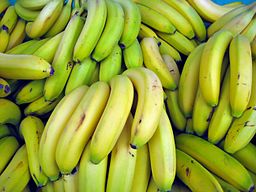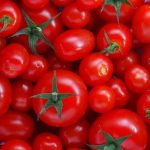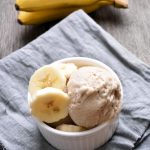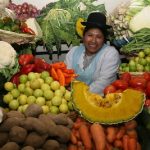
The banana is arguably the world’s most versatile fruit. While most commonly eaten raw, its soft creamy flesh can be baked, fried, grilled, sautéed, toasted or liquidised. They can also be used as the chief ingredient in a variety of breads, cakes, puddings, pancakes, ice-creams, smoothies, etc. As well as a great source of minerals and vitamins, bananas are also known to support a healthy gut and heart function, relieve indigestion, provide energy and promote good mood. Quite an impressive CV for what is now a relatively cheap everyday eatable for billions of people.

Photo credit: PxHere/CC0 1.0 Public Domain
Consumption
When talking ‘food’, I think ignoring the tomato’s spurious claim for status as a bona fide fruit is quite right. In which case, the banana easily takes the number one spot in terms of global fruit consumption. Well! that’s true if we can bring the banana’s slightly larger but almost identical twin, the plantain, into the equation. The predicted global consumption of bananas, including plantains, for 2024 is around 176 million tonnes. Incredibly, this amounts to well over 100 billion individual fruits, equating to a market value of some US$ 140 billion for the coming year. In terms of global production, the banana is the world’s fifth most important food crop, after wheat, rice, potatoes, and maize.
Origin
Bananas, like many other exotic fruits, are mostly grown in the tropical regions of Africa, Asia, Latin America, the Caribbean, and the Pacific. There are more than 1000 different varieties of bananas grown in some 150 countries throughout the world. Some experts believe that bananas were the first fruit on earth and originated from the jungles of Southeast Asia, where many wild varieties still grow.
The name ‘banana’ is thought to have arisen in Africa, being derived from the Arab word for ‘finger’. Almost inconceivably, the international trade in bananas began as early as the 14th century. The continuing development of transportation and technology, especially maritime refrigeration, has enabled the banana to become one of the world’s most exported crops.
Production and Export
India produces some 33 million tonnes of bananas annually and is thus by far the world’s biggest producer. Not unsurprisingly, the globe’s most multitudinous nation is also the world’s number one banana-consuming country. In terms of annual banana production, China comes a distant second to India, growing around 12 million tonnes per year. However, much like India, most of the country’s banana production is consumed domestically.
Ecuador is the world’s largest banana exporter, shipping around 7 million tonnes each year. The Latin American country, along with The Philippines, Colombia, Guatemala, and Costa Rica make up the world’s five biggest banana exporters. The ‘big five’ account for almost two-thirds of the global banana export trade, worth more than US$ 19 billion in 2023. What’s more, the underlying short to medium-term outlook for the fruit appears to be very positive. The appetite for bananas, along with other tropical fruits, has been gaining momentum throughout the past decade. The demand has been mostly driven by high-income growth and per capita consumption in developing countries, rather than that of mature markets such as Europe.
Nutritional Value of a Banana
A medium banana contains about 110 calories but has zero fat content. It also provides:
- 1 g of protein
- 3 g of fibre
- 28 g of carbohydrate (of which 15 g is naturally occurring sugar)
- 450 mg of potassium
- 25 mg of magnesium
A banana also provides 10 – 25% of the daily adult Recommended Dietary Allowance (RDA) for Vitamin A, Vitamin B6, and Vitamin C.
A Few Surprising Banana Facts
- Most kids usually take to eating bananas “like a duck to water”. Well, maybe that’s because a banana is actually 75% water.
- Horticulturally speaking, a banana is technically a berry, since its seeds are found inside the fruit’s skin.
- Per capita, Ugandans are the world’s biggest banana eaters. Each Ugandan scoffs an average of 200 kg per year.
- Sounds crazy but humans and bananas share around 50% of the same DNA.
- “Money doesn’t grow on trees”, so we’re told! As it turns out, neither do bananas! The banana plant is actually one of the world’s largest herbaceous perennials.
- The original Latin name for a banana, ‘musa sapientum’, translates to English as ” The fruit of wise men.”
- While ripe bananas are always yellow, plantains can also be variable shades of red and pink, together with blue and black.
Did You Know?
The idiom “going bananas” first appeared in the highly popular L’il Abner comic strip published in multiple newspapers across the Western world during the 1950s & 60s. The phrase was coined by the legendary American satirist, cartoonist and humorist, Al Capp.
Header image credit: Wikimedia Commons/CC BY-SA 3.0





